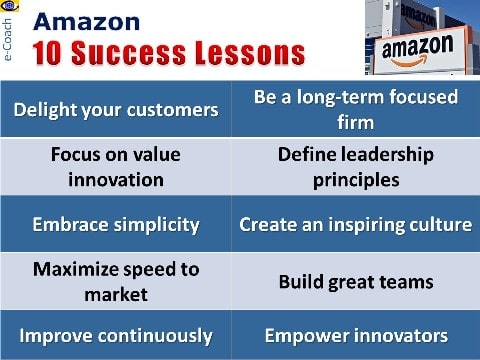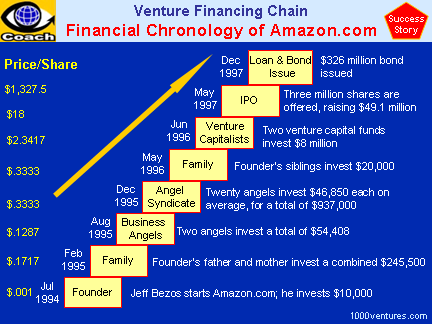| |
|
Success stories of companies
that changed the world
|
|
 |
 |
Amazon.com strives to be the
e-commerce destination where consumers can find and discover anything
they want to buy online. |
Jeff Bezos
Amazon |
| |
Amazon.com is a company that is
closely tied with the
e-commerce phenomenon. Jeff
Bezos, the founder of the
company,
broke the rules of the book
business by using the Internet
rather than conventional
distribution channels.
|
|
 |
|
 |
 |
We donít make money when we sell things;
we make money when we help people make purchase decisions. |
Jeff Bezos
Amazon |
 |
|
Amazon has grown
from a book seller to a virtual Wall Mart of the
Web selling diverse products.
The company has
also grown at a tremendous rate with revenue
rising from about US$150 million in 1997 to
US$5.2 billion in 2003. |
|
 |
We will continue to invest in systems,
people and product expansion, each of which helps us better serve
customers. |
Jeff Bezos
Amazon |
|
|
|
Amazon's Business Model
and Competitive Advantage
New
business model developed by Amazon.com creates
value for customers by offering a synergistic
combination of the following benefits:
Shopping convenience
Ease
of purchase
Speed
Decision-enabling information
A
wide selection
Discounted pricing
Reliability of order fulfillment.
No
single aspect of Amazon.com's
business model is sufficient to create a
sustainable competitive advantage. It is the
synergistic combination of all of these
information services and logistical processes
that
creates value for customers and comprise
Amazon.com's competitive advantage.
Direct model enables Amazon.com to shorten
shipping times. The company invested also
heavily in warehousing and material handling
systems to achieve multifold improvement in
throughput.
|
|
|
|
|
Building Brand Equity
Amazon.com has steadily increased its spending
on advertising and promotion to make its
brand stronger and build
brand equity. By 2003, the brand of
Amazon.com was worth US$ 22 billion. "A
brand for a company is like a reputation for
a person. You earn reputation by trying to do
hard things well," says Jeff Bezos, the founder
of Amazon.com.
Value Added Information Services
Amazon.com works hard to achieve value-added
differentiation through customer-focused
information services. Amazon.com's site retains
customer preferences and provides automated
customization for users.
Jeff
Bezos has a vivid vision for how this technology
will be used: "Personalization is like
retreating to the time when you have small-town
merchants who got to know you, and they could
help get the right products. The right products
can improve your life, and the wrong products
detract from it. Before the era of mass
merchandizing, it used to be that most things
were personalized. The purpose of ...
customization is ... you get the economies of
mass merchandising and the individuality of
100-years-ago merchandising."
|
|
|
|
|